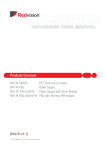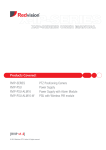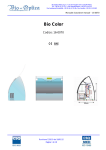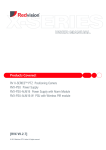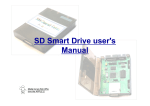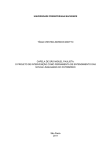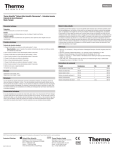Download ST6 Woodchipper
Transcript
Rapid deployable CCTV camera system USER MANUAL 12/6/2014 Revision 1 Redvision CCTV Ltd, 17 Highview, High Street, Bordon, Hampshire, GU35 0AX, United Kingdom Page |1 Table of Contents Introduction............................................................................................................................................ 1 Purpose of machine ............................................................................................................................. 3 Exterior component identification....................................................................................................... 4 Safety ..................................................................................................................................................... 5 Safe working ..................................................................................................................................... 5 DOs and DON’Ts ............................................................................................................................. 7 Transportation ....................................................................................................................................... 8 Routine maintenance ........................................................................................................................... 8 Fastener tightening torques ............................................................................................................ 9 Cabinet covers ................................................................................................................................ 10 Battery .................................................................................................................................................. 11 Battery safety information ............................................................................................................. 11 Storage and transport .................................................................................................................... 11 Initial operation ............................................................................................................................... 11 Battery removal & maintenance ................................................................................................... 11 Charging .......................................................................................................................................... 12 Taking battery out of service ........................................................................................................ 12 Warranty .............................................................................................................................................. 13 CE Certificate ...................................................................................................................................... 14 Introduction Thank you for hiring this Redcop rapid deployable CCTV security system. By observing the contents of this manual, we hope the machine gives safe and productive service. This user manual is intended for the hirer/operator to safely and effectively operate this machine. This is not a comprehensive service manual. This machine has been through a pre-delivery inspection before leaving Redvision CCTV Ltd and is ready to use. Before use and as a minimum, the safety and machine operation sections covered on pages 4 to 7 must be read and understood. Failure to do so could result in serious injury or loss of life to the operator and others nearby. Also, damage to property and this machine may occur. Please observe and obey all warning signs (decals) located on the machine. All personnel working with this machine must be adequately trained in its use and most importantly, follow the advice on safe working practices. Page |2 Redvision CCTV Ltd endeavour to continuously develop and improve its products. They reserve the right to make changes at any time, without notice or incurring any obligation. Continuous improvement will affect machine design and production so there may be minor discrepancies between the actual product and this manual. This manual must remain with the machine for reference by operators and includes hiring or if the machine is resold. Independent power duration Input power Mast height Overall weight Operational foot print 1 to 4 days 90Vac to 264Vac 10A Max 4 to 6m (extension option to 7m) 550 to 650Kg depending on battery configuration 3.08m x 1.75m Page |3 Purpose of machine Redcop is designed to provide a hire service on-site CCTV security in a rapid deployable form via trailer transport or pallet delivery to site. Page |4 Exterior component identification Figure 1 Page |5 Safety Safe working Before using this machine, make sure that you are trained and fluent in its operation. Know the location of and how to use all the safety features. Know how to control raising and lowering the mast, powering down and isolating the machine in an emergency. Be familiar with the hazards and safe working practices to prevent injury and damage to property and machine. 1. The minimum age for service personnel is 18 years. Personnel aged 16 can use the machine for training under supervision by a suitably trained person of 18 years or over. 2. Operators and personnel working with this machine must not be under the influence of alcohol, drugs or medication that would impair judgement, concentration or reaction times. Excessive tiredness is also a risk. 3. Maintain an exclusion zone around the machine outriggers and clearly mark if in a public area. 4. Make sure the machine is on even, level and stable ground and cannot move or topple when in use. Use packers and or surface protectors under the cranked support feet if necessary. 5. Keep children and animals well away from the working area, particularly while raising or lowering the mast. In this instance, a 10m exclusion zone must be maintained for all other than the operator. 6. Carefully site the machine so operators can work furthest from any local danger. For example, on a road side, place machine so operators work on the verge and not in the road exposed to traffic. Page |6 Machine lifting The lifting eye is designed for securely holding the machine’s weight only when the mast is fully collapsed, secured with shoot bolts and securely fastened to the rest. The outriggers must also be removed. Do not use hoist hook directly on the lifting eye. Use a correctly rated safety shackle. Inspect lifting eye before each use and do not use if damaged. Figure 2 Page |7 DOs and DON’Ts DO electrically isolate the machine before making any adjustments or cleaning. DO fit, secure and correctly deploy outriggers before raising mast. DO ensure that the machine is level, well supported and cannot move during use. DO ensure all equipment cabinets and central covers are securely locked before leaving unattended. DO conduct regular machine checks for mechanical and electrical problems. DO keep well away from mast when raising and lowering. DO NOT allow anyone other than the operator within 10m when mast is being raised or lowered. DO NOT rise the mast without the outriggers correctly and securely fitted. DO NOT attempt to climb the mast when raised. DO NOT tamper with the mast hydraulics or inspect while under pressure eg. while in any position other than fully raised or lowered and the pump flow control valve lever in neutral. DO NOT lift machine with the lifting eye unless the mast is fully collapsed, secured with shoot bolts and securely fastened to the rest. DO secure mast base to chassis when fully raised. DO NOT let anyone who has not received instruction, operate the machine. DO check for mast deployment hydraulic oil leaks. DO NOT climb on the machine at any time. DO NOT touch any exposed wiring while the machine is in operation. Page |8 Transportation • When towing the machine the maximum legal speed limit is 60mph. • On very rough and uneven road surfaces, reduce speed to protect the machine from undue vibration. • Avoid steep gradients when off road. • Avoid excessively pot holed ground. • Exercise caution when reversing the trailer as the short wheel base will react quickly to steering. • Ensure the mast is collapsed, fastened with shoot bolts and securely fastened to the mast rest, outriggers are removed, centre panels and cabinets secured closed before departing. • Use lashing eyes on the chassis underside to secure within the trailer. Routine maintenance There are no user serviceable items on Redcop but if problems are noticed or faults occur, report these to Redvision CCTV Ltd. • If checking for hydraulic faults, beware of hydraulic oil leaks, they can cause serious injury while the system is under pressure. A leak can easily inject high pressure oil deep into flesh and blood stream requiring immediate medical attention. DO NOT CHECK FOR LEAKS WHILE THE MAST IS IN ANY POSITION OTHER THAN FULLY RAISED OR LOWERED AND THE HYDRAULIC CONTROL VALVE LEVER IS IN NEUTRAL. Hoses to the mast cylinder are the most likely to become damaged as they move while the mast is raised or lowered. Page |9 Fastener tightening torques Tightening torques for class 8.8 and 10.9 fasteners Class 8.8 Class 10.9 Nominal Nominal Max/Min Max/Min torque torque torque torque Nm Nm Size M6 M8 M10 M12 M16 M20 M24 10 25 49 86 210 410 710 9.5/10.4 23.1/25.3 46/51 80/87 194/214 392/431 675/743 14.5 35 72 125 310 610 1050 14/15.3 34/37.2 68/75 117/128 285/314 558/615 961/1059 All machine fastener torques should be checked periodically to the above table. In particular, those for the mast pivot, axle fixing, outrigger and cranked support. P a g e | 10 Cabinet covers Figure 3 Figure 4 P a g e | 11 Battery Battery safety information 1. Battery acid is highly corrosive. For safety reasons, wear eye protection when handling a battery. Do not tilt battery as acid could escape from vents. 2. Keep children away from acid and batteries. 3. Battery emits highly explosive hydrogen gas when charged. Do not allow fires, sparks, naked flames or smoking near the battery. Also avoid electrostatic discharges and electrical sparks when dealing with cables and electrical equipment. 4. First aid. If acid is splashed into eyes, immediately rinse with clean water for several minutes and consult a doctor without delay. If acid is swallowed, consult a doctor immediately. Neutralise acid splashes on the skin and clothes immediately with acid neutraliser (a solution of water and soda/baking soda) or soap suds, and rinse with plenty of clean water. 5. Battery case can become brittle. To help avoid this, do not store batteries in direct sunlight. Discharged batteries could freeze so store in a frost-free area. 6. Dispose of old batteries at an authorised collection point. Never dispose of in household waste. Storage and transport 1. As batteries are acid filled, always store and transport them upright and prevent from tilting to avoid acid escape. 2. Store in a cool, dry, frost free place. 3. Do not remove the protective positive terminal cap. 4. Run a First-in First-Out (FIFO) warehouse management system. Initial operation 1. Batteries are filled with acid at a density of 1.28g/ml at 15°C during manufacture and are ready for use. 2. Recharge in case of insufficient starting power (see charging). Battery removal & maintenance To remove and replace battery: 1. Switch off all electrical equipment. 2. To gain access to the battery, lift the two cabinet covers either side of the mast. 3. Avoid short circuiting the battery terminals and from positive to any metal machine part. Loose metal parts and tools commonly cause this. 4. Remove any debris from around the battery. 5. First remove negative lead at the battery, then the positive. Battery terminals are the take-off type and fastened with an M6 screw in to a ferrule on the cable end. P a g e | 12 6. Slacken the ratchet strap securing each battery. 7. Remove battery. Clean with a moist anti-static cloth to avoid electrostatic discharge and explosion risk. Charge and check electrolyte level if appropriate. 8. Clean out battery tray. Apply a thin film of petroleum jelly to terminals to prevent corrosion. 9. Replacement is the reversal of removal. Ensure to replace/fit any vent pipes. Leave at least one vent open otherwise there is an explosion risk. This also applies to old batteries removed for disposal/recycling. Swap new battery positive terminal protective cover to the old battery positive terminal to help prevent short circuits and sparks. Charging 1. 2. 3. 4. 5. 6. 7. 8. 9. Remove battery from machine, disconnect negative terminal first. Ensure good ventilation. Use suitable direct current mains chargers only. Connect battery positive terminal to charger output positive. Connect the negative terminal accordingly. After connection, switch on charger. When charging is complete, switch off charger then disconnect battery. Charging current recommendation is 10% of the battery Ah power rating. Use a charger with a constant charging voltage of 14.4V. If the acid temperature rises above 38°C, stop charging. The battery is fully charged when the charging voltage or acid specific gravity has stopped rising for two hours. Taking battery out of service 1. Charge the battery and store in a cool but frost free place or on the vehicle with the negative terminal disconnected. 2. Check the battery charge at regular intervals. Recharge if necessary. P a g e | 13 Warranty Warranty statement 1. Redvision CCTV Ltd guarantee all Redcop equipment supplied by them against any defect in manufacture and assembly – this guarantee is for a period of 12 months commencing on the date of sale to the first end user. 2. The guarantee will not apply to a failure where normal use has exhausted the life of a component. 3. Redvision CCTV Ltd’s liability under this guarantee is limited to repair at Redvision CCTV Ltd’s premises or at a selected Redcop dealer. 4. No liability will be accepted for consequential lost or damage of any kind. 5. The Redvision CCTV Ltd guarantee is restricted to the first Redvision CCTV Ltd user only and is not transferable except when authorized by Redvision CCTV Ltd. 6. The owner is responsible to make sure the machine is operated at all times in accordance with the user manual. 7. The Redvision CCTV Ltd guarantee will be invalidated if any of the following points apply; • • • • • • • Failure to use genuine Redcop parts Failure to perform routine servicing and maintenance Failed parts or assembly have been interfered with Machine has been modified without written approval from Redvision CCTV Ltd Machine has been used to performed tasks contrary to those stated in the Redvision CCTV Ltd User Manual Exclusions to the above warranty terms are – fair wear and tear on electronics, tyres and paintwork. Where an extended warranty has been given this will be stated on the original machine invoice and will be subject to further conditions as stated in our supplementary warranty terms Warranty claims To obtain warranty service please contact Redvision CCTV Ltd for the nearest approved Redcop Dealer. Your nearest dealer can be obtained from Redvision CCTV Ltd at the address on the front of the User Manual. In the event of a failure Redvision CCTV Ltd must be notified within 7 working days. P a g e | 14 CE Certificate CERTIFICATE & DECLARATION OF CONFORMITY FOR CE MARKING Company contact details: Redvision CCTV Ltd, 17 Highview, High Street, Bordon, Hampshire, GU35 0AX, United Kingdom Redvision CCTV Ltd declares that their: Rapid deployable CCTV security system listed as the following models Redcop are classified within the following EU Directives: Machinery Directive 2006/42/EC Electromagnetic Compatibility Directive 2004/108/EC and further conform with the following EU Harmonized Standards: EN13525:2005 + A2:2009 EN 982:1996+A1:2008 EN ISO 12100:2010 EN ISO 14982:2009 Dated: ………………………… Position of signatory: Managing Director Name of Signatory: Paul Hucker Signed below: …….………………………………. on behalf of Redvision CCTV Ltd

















